We’ve been amazed at how much there is to see in South Dakota and to think we’ve only been in the bottom third of the state! In the Rapid City area, you’re not only close to Mt. Rushmore and the Crazy Horse Memorial, but also to some of the most beautiful scenery we have seen on our journey thus far, nearly all located in the Black Hills National Forest. In this blog entry I’m going to tell a little about each area we visited and then post several pictures because as they say pictures are worth a thousand words.
Wind Cave National Park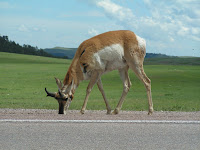
There are two impressive caves in the area but Wind Cave was the closest and the one we chose to visit. However, we had already decided we weren’t going to spend the money to go in the cave but instead we’d stop at the visitor center and then travel the scenic roads throughout the park. Wind Cave National Park (
http://www.nps.gov/wica/) was the first cave

to be designated a national park and has several unusual formations. The park covers 28,295 acres of open prairie and home to bison, pronghorn, prairie dogs, ferrets, and elk. Driving along we came upon a large number of bison including several reddish-brown calves grazing in the fields. As we stood watching, suddenly fr

om behind a knoll five pronghorns came running out onto the field! Soon a few more joined them, drinking from the pond and grazing in the fields as well. A few minutes later two of the pronghorns began locking horns, but I don’t believe they were fighting but merely playing.
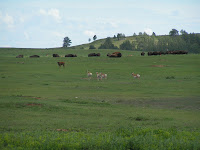


As we continued our drive out of the park, we came across the town of Hot Springs, SD, driving through the historic downtown district with several pink sandstone buildings dating back to the early 1900s.
Custer State Park
Within Custer State Park (
http://www.sdgfp.info/Parks/Regions/Custer/custersp.htm htm
htm) are three scenic areas: Needles Highway, Iron Mountain Road, and Wildlife Loop Road. Nearly 1,600 bison/buffalo freely roam this 71,000 acre park in the Black Hills. Since there was so much to see, we spread our drives over several days. One morning we loaded the dogs in the car and took off for the park planning to drive Needles Highway and the Wildlife Loop Road. Shortly after entering th

e park, we saw this bison on the side of the road pretty much ignoring everyone while grazing. However you don’t want to mess with bison!
Needles Highway is a 14-mile road that twists and turns its way past tall pines, towering rock formations, and through narrow tunnels. Along the highway are 3 of the 6 hard rock

tunnels located within the park, 4 of which are one lane…watch carefully and honk before entering! We went through two that were roughly 12’ tall and 9’ or slightly less wide. Russ has become quite the climber it seems as you can see him perched near the top of one of the tunnels when you open the picture. The road’s name comes from the needle-like granite formations that seem to pierce the sky, and there
is one
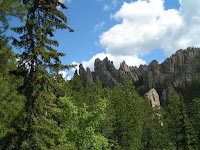
formation in particular called the Needle’s Eye because of the opening created by erosion that makes it appear like the eye of a needle. There are also a series of pinnacles that resemble church spires called the Cathedral Spires.







Our drive took us to a height of 6,363 feet with incredible views. We stopped at the Sylvan Lake Campground to check it out and there we met Tarrah, who works for the SD State Park Service. She loved meeting the dogs as she was a vet tech for awhile in CO, but she says that Custer State Park always draw

s her back as this is her 3rd year working for the park. She loves the area and we thoroughly enjoyed spending probably half an hour talking with her. What a great gal and we wish her all the best in her future endeavors.
Shortly af
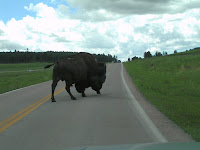
ter we began driving on the 18 mile Wildlife Loop Road, a bison crossed the road right in front of us. Told you they roam freely! And then we met the “begging burros” who also roam freely. These creatures stand in the middle of the road, poke their noses in car windows, and take just about any food you’r

e willing to give them. Everyone gets out of their car to pet and/or feed them and of course take pictures. You’re warned not to feed the wildlife and to be careful approaching them because they are still wild animals. Of course, we got out of the car, and Russ walked over to pet one. We didn’t have any food, but a lady in one of the cars gave Russ a slice of bread to feed him, and the burro seemed

hesitant at first. So Russ told the burro (yes, he was talking to the animals) that he wasn’t going to beg him to take the bread, which is what’s he’s saying in the photo. The burro did finally take it. Further along the drive we saw more pronghorn, buffalo, and some mule deer. We’re so glad we had the time to truly enjoy both these roads and not have to rush. The beauty cannot be truly described in these paragraphs or even in the pictures.

The next day we again loaded the dogs in the car to drive the 17 mile Iron Mountain Road. Completed in the 1930s, this road has twists and turns, 3 more tunnels (one of which is one lane), and pigtail bridges meaning the road curls and passes over itself. These bridges enabled road engineers to reduce elevation without needing to

build a switchback. Iron Mountain Road is one way of getting to Mount Rushmore and the three granite tunnels frame Mount Rushmore perfectly in the distance. What an incredible view!



On this drive we saw more pronghorn and once again ran into a group of burros in the middle of the road. Of course we got out again, but this time Russ had the camera. Three of them were right next to my door, nearly making it difficult for me to get out. One had an itch behind his ear and kept trying t

o scratch it on the side view mirror. At one point I thought the mirror was going to come off! Again we had no food for them, so I tried to explain that to one of the burros. The dogs really wanted to go out and play, barking and whining at the burros, and at one point Mikey was nearly nose to nose with one through the slightly opened window!
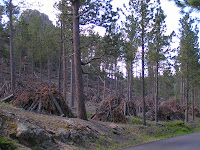
Both days we saw hundreds of piled logs and branches throughout the forests. Our guess was that they were burn piles for prescribed burns which is a policy of the National Park Service. We figured it must take an army to make all those piles, but we learned from one of the park rangers that actually about 4-6 individual contractors do all the work. He said it is quite a sight to see, this small crew hustling and moving from one section to the next.
City of Presidents 
Rapid City, SD, is known as the City of Presidents because of its life-size bronze sculptures of 35 past U.S. presidents that are on display throughout the downtown 15 square block area. This project was begun in 2000 with 4 sculptures and each year thereafter two of the early presidents and two from the modern years have been added. I didn’t get pictures of all but below are four that came out pretty good: Grant, JFK with John-John, Teddy Roosevelt, and Nixon.
 htm) are three scenic areas: Needles Highway, Iron Mountain Road, and Wildlife Loop Road. Nearly 1,600 bison/buffalo freely roam this 71,000 acre park in the Black Hills. Since there was so much to see, we spread our drives over several days. One morning we loaded the dogs in the car and took off for the park planning to drive Needles Highway and the Wildlife Loop Road. Shortly after entering th
htm) are three scenic areas: Needles Highway, Iron Mountain Road, and Wildlife Loop Road. Nearly 1,600 bison/buffalo freely roam this 71,000 acre park in the Black Hills. Since there was so much to see, we spread our drives over several days. One morning we loaded the dogs in the car and took off for the park planning to drive Needles Highway and the Wildlife Loop Road. Shortly after entering th e park, we saw this bison on the side of the road pretty much ignoring everyone while grazing. However you don’t want to mess with bison!
e park, we saw this bison on the side of the road pretty much ignoring everyone while grazing. However you don’t want to mess with bison! tunnels located within the park, 4 of which are one lane…watch carefully and honk before entering! We went through two that were roughly 12’ tall and 9’ or slightly less wide. Russ has become quite the climber it seems as you can see him perched near the top of one of the tunnels when you open the picture. The road’s name comes from the needle-like granite formations that seem to pierce the sky, and there is one
tunnels located within the park, 4 of which are one lane…watch carefully and honk before entering! We went through two that were roughly 12’ tall and 9’ or slightly less wide. Russ has become quite the climber it seems as you can see him perched near the top of one of the tunnels when you open the picture. The road’s name comes from the needle-like granite formations that seem to pierce the sky, and there is one formation in particular called the Needle’s Eye because of the opening created by erosion that makes it appear like the eye of a needle. There are also a series of pinnacles that resemble church spires called the Cathedral Spires.
formation in particular called the Needle’s Eye because of the opening created by erosion that makes it appear like the eye of a needle. There are also a series of pinnacles that resemble church spires called the Cathedral Spires.
 ter we began driving on the 18 mile Wildlife Loop Road, a bison crossed the road right in front of us. Told you they roam freely! And then we met the “begging burros” who also roam freely. These creatures stand in the middle of the road, poke their noses in car windows, and take just about any food you’r
ter we began driving on the 18 mile Wildlife Loop Road, a bison crossed the road right in front of us. Told you they roam freely! And then we met the “begging burros” who also roam freely. These creatures stand in the middle of the road, poke their noses in car windows, and take just about any food you’r e willing to give them. Everyone gets out of their car to pet and/or feed them and of course take pictures. You’re warned not to feed the wildlife and to be careful approaching them because they are still wild animals. Of course, we got out of the car, and Russ walked over to pet one. We didn’t have any food, but a lady in one of the cars gave Russ a slice of bread to feed him, and the burro seemed
e willing to give them. Everyone gets out of their car to pet and/or feed them and of course take pictures. You’re warned not to feed the wildlife and to be careful approaching them because they are still wild animals. Of course, we got out of the car, and Russ walked over to pet one. We didn’t have any food, but a lady in one of the cars gave Russ a slice of bread to feed him, and the burro seemed hesitant at first. So Russ told the burro (yes, he was talking to the animals) that he wasn’t going to beg him to take the bread, which is what’s he’s saying in the photo. The burro did finally take it. Further along the drive we saw more pronghorn, buffalo, and some mule deer. We’re so glad we had the time to truly enjoy both these roads and not have to rush. The beauty cannot be truly described in these paragraphs or even in the pictures.
hesitant at first. So Russ told the burro (yes, he was talking to the animals) that he wasn’t going to beg him to take the bread, which is what’s he’s saying in the photo. The burro did finally take it. Further along the drive we saw more pronghorn, buffalo, and some mule deer. We’re so glad we had the time to truly enjoy both these roads and not have to rush. The beauty cannot be truly described in these paragraphs or even in the pictures. 
No comments:
Post a Comment